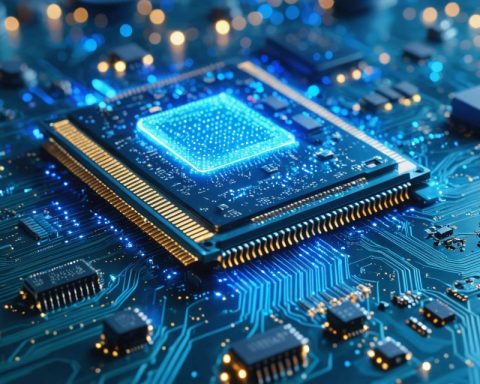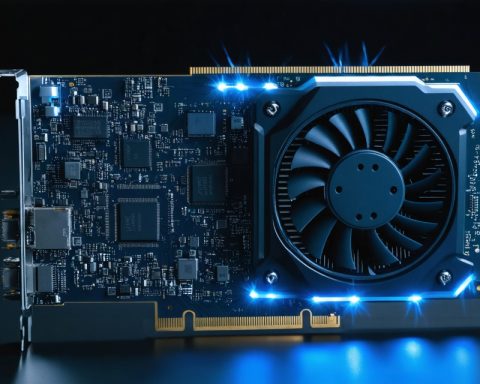AMD’s Struggles Amidst Market Gains
Advanced Micro Devices (AMD) has faced a challenging year, with its stock plummeting nearly 21% in 2024, even as the PHLX Semiconductor Sector index flourished with a 24% increase. Over the last five years, AMD has mirrored this trend, gaining 141%, but lagging behind the sector’s 170% increase. A multitude of factors have contributed to AMD’s stagnation, including a weakened personal computer market post-pandemic, declining gaming console demand, and a missed opportunity in the soaring artificial intelligence (AI) sector, which rivals like Nvidia have successfully capitalized on.
Nevertheless, signs of potential recovery exist for AMD, yet concerns linger about two emerging contenders that could overshadow its market value in the coming five years.
Palantir Technologies has experienced explosive growth, with its stock skyrocketing 301% over the past year, drawing closer to AMD’s market capital. The company’s innovative Artificial Intelligence Platform has attracted numerous customers eager to enhance operational efficiency. Analysts project Palantir’s annual revenue could surge to $2.8 billion in 2024, marking a 26% increase, supported by a growing customer base.
Similarly, Arm Holdings has made remarkable strides, boasting a 100% rise last year. As a leader in licensing chip designs, it plays a pivotal role in the smartphone sector and is expanding its reach into cloud computing and Internet of Things markets. With robust earnings projections ahead, Arm’s growth trajectory poses a significant challenge to AMD’s standing.
An Examination of AMD’s Market Position: Broader Implications
AMD’s current predicament encapsulates a broader narrative within the technology sector, reflecting significant societal shifts that are reshaping market dynamics. The stagnation of traditional computing devices and the decline in gaming console popularity signal a transition in consumer preferences towards more integrated and versatile solutions, such as mobile devices and cloud-based applications. As modern lifestyles intertwine more with technology, companies that fail to adapt to these shifts risk losing relevance.
Culturally, the impact of AI and advancing technologies are drastically altering the job landscape, where firms like Palantir and Arm lead the charge. These companies are not merely riding the wave of innovation; they are setting the pace for what’s next in AI and chip design. As their technologies become embedded in various sectors, from healthcare to automotive, the implications extend beyond business performance into ethical considerations surrounding employee roles and data privacy.
Environmentally, the shift toward AI and more efficient technologies may foster innovation that addresses sustainability concerns. However, it also raises questions about the resource allocation and energy consumption of data centers supercharged by AI. Trends suggest a gradual movement towards green technologies, but this may require significant investment in research and development—an area where AMD must refocus to retain competitiveness.
As we look to the future, long-term significance hinges on AMD’s adaptability. The semiconductor industry is poised for transformative growth, albeit with a heightened focus on addressing these cultural, economic, and environmental challenges. Companies that can innovate while embracing sustainability will likely lead the charge in this new technological epoch.
AMD’s Road to Recovery: Can it Compete Amidst Rivals?
Market Overview: AMD’s Persistent Challenges and Rivals’ Growth
Advanced Micro Devices (AMD) has encountered significant obstacles in 2024, with its stock dropping nearly 21%, contrasting sharply with the booming PHLX Semiconductor Sector index, which saw a 24% increase. Over the past five years, AMD managed a respectable gain of 141%; however, this is outpaced by the sector’s overall increase of 170%. Various factors have contributed to AMD’s struggles, including the weakened personal computer market post-pandemic, declining gaming console demand, and a notable absence in the rapidly growing artificial intelligence (AI) sector—an area where competitors like Nvidia have been thriving.
Current Innovations and Market Trends
Despite these challenges, AMD is poised for potential recovery. Key innovations in semiconductor technology and shifts toward more advanced AI capabilities may play a crucial role in unlocking new markets and revenue streams. Analysts suggest that with upcoming product launches, particularly in the artificial intelligence and data center realms, AMD could regain some market traction.
Key Competitors and Their Impact
Palantir Technologies
Palantir Technologies has emerged as a formidable competitor, witnessing a staggering 301% increase in stock value over the past year. Their focus on AI-driven solutions has attracted a growing list of clients seeking to enhance operational efficiencies. Analysts predict that Palantir’s annual revenue could reach $2.8 billion in 2024, highlighting a 26% increase driven by their expanding customer base.
Arm Holdings
Another competitor on AMD’s radar is Arm Holdings, which has seen its stock double in the last year. Known for its licensing of chip designs, Arm is integral to the smartphone ecosystem and is broadening its influence in cloud computing and the Internet of Things (IoT). As Arm progresses with robust earnings projections, its continued growth poses a significant challenge for AMD, particularly as it attempts to solidify its position within these high-demand markets.
Emerging Strategies and Future Predictions
AMD’s strategic focus appears to be shifting. As they look to recover, the company might enhance partnerships and collaborations, particularly in AI and semiconductors, to expedite innovation and market penetration. The potential for AMD to diversify its product offerings could also position it better against its competitors.
Market analysts predict that if AMD can effectively leverage its existing technologies while adapting to the evolving tech landscape, it may close the gap with its rivals over the next few years. This effort will likely include an emphasis on sustainability and cutting-edge research, aligning with broader industry trends that favor environmentally responsible practices.
Conclusion
As AMD navigates its way through a challenging landscape marked by competition from Palantir Technologies and Arm Holdings, the path to recovery involves innovation, market adaptation, and enhanced strategic focus. Keeping an eye on emerging technologies and customer needs will be imperative for AMD as it strives to reclaim its standing in the semiconductor sector.
For more insights on semiconductor trends and technology innovations, visit AMD’s official page.











